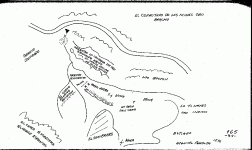I agree with you. There may have been some mineral-based poking around in today's AZ by the Spanish, but they pretty much kept to the Santa Cruz Valley, Santa Rita Mountains, etc. They were more interested in trying to establish secure access routes to CA. [There was the Kino presence, sure, but the 'Jesuit mining' allegations remain speculative, IMO - especially in the Superstitions.]
Most of the military-supported Spanish mineral exploring was in New Mexico before 1821, in the Santa Rita del Cobre and Santa Fe regions. Some of this spilled into AZ: forays led by Menchero, Mogollon, etc., who were focused on the Todos Santos area of the Upper Gila, spread out as far west as the Clifton, AZ vicinity. Further north, Spanish prospectors working through Santa Fe were somewhat active in CO. Apaches, Utes and other natives were a big problem for the Spanish mineral explorers, who didn't have the resources to protect remote activity.
Nearly all the pre-Anglo mining in the Southwest was Mexican, not Spanish. There was a lot of 'looking around', but a mining venture was very costly and logistically difficult beyond the Northern Frontier. Any activity in the Superstitions, such as the alleged Peralta mining (if it existed) was undoubtedly from the Mexican period, officially 1821-1848, but with overlap before and after (~1810-1860). If Thorne's story is true, he very likely found a cache of Mexican ore.




 Care to elaborate?
Care to elaborate? 
